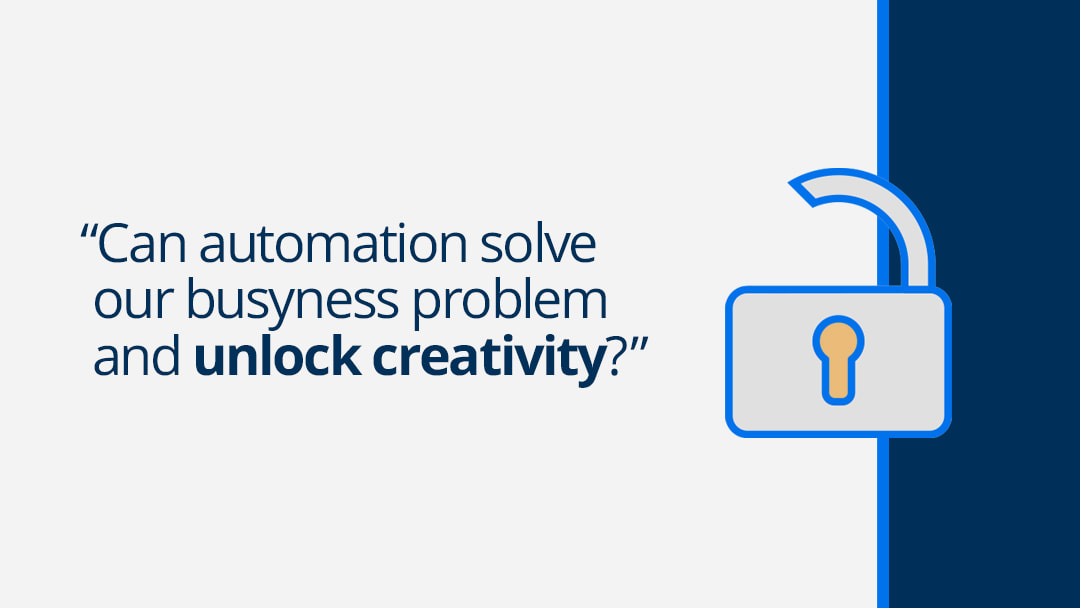|
Automation can free up time by taking over tasks. But turning that free time into time for innovation takes practice. Most business leaders will tell you that creativity is critical to business success. In a study by Forrester, 82% of leaders surveyed believed in a strong connection between creativity and business results. And that’s not just perception. Companies with cultures that encourage creativity outperform their competitors by driving innovation, revenue growth, and market share. Furthermore, over two-thirds of the companies that were ranked highly for fostering creativity have received awards and recognition for being a “best place to work.” Creativity — or the ability to be creative at work — is also important to employees, and may be lacking. Nearly a third of employed U.S. adults would take a pay cut for a job that allowed them to be more creative, according to a Creative Live survey. Too Busy to Be CreativeIf creative work is so important, why is there such a lack of creativity? In large part, creativity suffers when we are too busy multi-tasking. The “culture of busy” hinders our ability to come up with fresh, innovative ideas. When you’re busy being busy, there’s no room for creativity; in business, that translates to less innovation. So what does it look like to make room for creativity? Researchers have found that letting our minds wander can facilitate creative problem solving. Daydreaming gives us access to the big-picture state of mind that cultivates creative thinking. When our brain is at rest — or at least not focusing attention on something or working hard to filter out distraction — the creative juices can flow. Can Automation Unlock Creativity?True daydreaming is rare these days. Now, when we take a break or procrastinate, we replace letting our minds wander with “productive” activities like checking social media, news feeds, and Reddit. We make ourselves busy even in our leisure time, thereby filling the space that’s needed to truly be creative. So, can automation solve our busyness problem and unlock creativity? Not exactly. But it can give us back more time for daydreaming and other creative endeavors. Think about which tasks you do every day that could be automated; any task that’s repeatable or replicable could be set up to happen automatically, giving you time back in your day. Imagine if you could automate follow-up processes for getting approvals, for instance, so you didn’t have to spend time tracking down key stakeholders for signoff. Or how much more you could accomplish if you could automate handoffs between teams, rather than scheduling a series of “check in” meetings. Or what you would do with the time you’d get back by letting a self-driving car take over your commute. Or Will It Just Make Us Busier?Automation can let us maximize our waking hours to do what’s most important. This idea isn’t new; the age-old promise of technological advancements was that they would give you back more time to spend on what was important — or at least on getting more done. But therein lies the danger: that we will just do more of the same, finding other ways to be busy even as automation helps us be more productive. So it’s critical that we carve out time to be creative. Because creativity requires quiet, reflective, uninterrupted time. Take Back the TimeAs automation frees up time by taking over tasks, give yourself permission to daydream and space to let your mind wander. Create boundaries and define creative space.
Easier said than done, but technology may be able to help. As we turn to automation to give us time to think, we can work with our devices to hold us to our commitments to set aside creative time. Much like we can set our phones to “Do Not Disturb” at night to quell the constant alerts and vibrations so we can catch some zzzs, we could set our devices to shut down or lock us out during the times we want to let our mind wander in the quest for creative ideas. However we make it happen, taking the time to be creative can make work more meaningful, drive innovation, and help our businesses outperform their competitors in revenue growth and market share. Automation promises to make that possible — but only if we make the most of the time it gives back to us. |
|
Care line: +603-9212 0157
|
Leave us your inquiry |
|
This company is registered with the Ministry of Finance, Malaysia.
Equip your organisation with digital solutions & training that inspire innovation and joy at work. Copyright © 2024 57Network Consultancy Sdn. Bhd. Company Registration number : 202001020346 (1376666-K) All rights reserved. |










